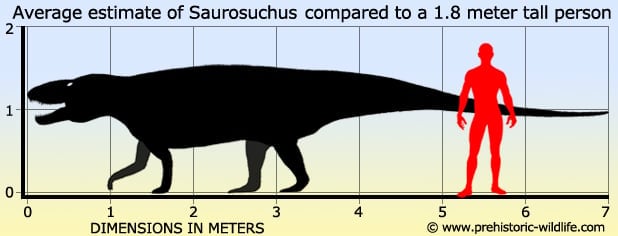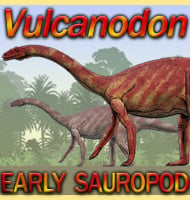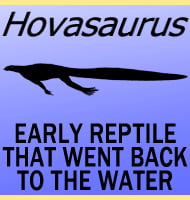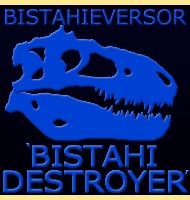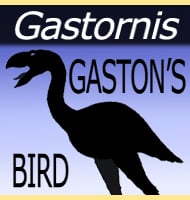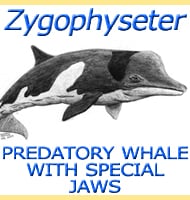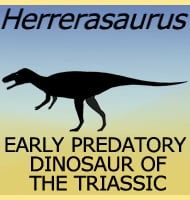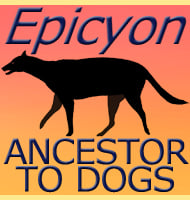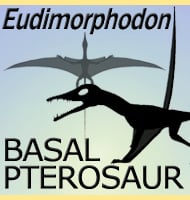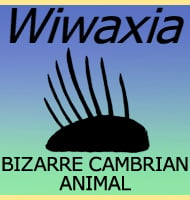In Depth
Unfortunately Saurosuchus is only known from incomplete remains, but those that are known indicate that it was big. Key to identifying the fossils as being those of a predator is the skull that has several classic predatory characteristics. One is the fact that the skull is wider at the back than at the snout which not only suggests housing for strong biting muscles but also eyes that were slightly angled forwards for depth perception. This would allow for easier prey location as well as timing of strikes so that Saurosuchus could more successfully deliver a mortal bite that would result in the death of the prey. The exact method of execution may have varied according to prey however, with small animals being killed outright by the teeth and crushing jaws, while large prey may have been bitten but then allowed to weaken by bleeding to death before the final kill. The back of the skull however features attachments for strong neck muscles which might suggest that Saurosuchus clamped its jaws and held onto prey as it struggled, something that would require strong neck muscles to support the skull so that the prey could not shake itself free.
The teeth of Saurosuchus are thought to have been replaced over the course of its life so that when a tooth became worn and lost, another would grow in to take its place. This would compensate for tooth loss caused by overly powerful attacks upon large animals that may have caused some teeth to be broken as they struggled while being bitten. Tooth replacement is also seen in modern crocodiles and also existed in the dinosaurs. Another similarity Saurosuchus shares with the crocodiles (as well as phtyosaurs) is that the maxillae and snout are pitted, although the pitting is not as well developed in Saurosuchus. These pits are attachment points for tissues, and the under developed pits of Saurosuchus suggest that its skulls soft tissues were not as strong or specially developed as the later phytosaurs and crocodiles. Such pitting of the skull is so far not known in other rauisuchian however, which might suggest that Saurosuchus was at a more advanced stage of development.
Like other rauisuchians, Saurosuchus is thought to have had a quadrupedal posture in order to support its larger size and weight. While slowing Saurosuchus down when compared to bipedal reptiles, it was probably not a hindrance as there were plenty of reptilian prey animals that would have been just as slow if not slower. A lower quadrupedal posture also explains the development of osteoderm armour along its back. While quadrupedal Saurosuchus would have been able to climb onto the back of another, and if two Saurosuchus came into conflict over territory or the right to feed from a kill, the armour may have helped protect Saurosuchus from being bitten on a critical area like the spine from another. This would allow for a weaker or more submissive individual to withdraw from a fight injured but still alive.
Further remains of teeth and skull fragments from the Chinle Formation of Arizona were attributed to the genus in 2002, but today these remains are considered to be too indeterminate for classification. Unless more complete material is found at a later date, the geographic distribution of Saurosuchus will remain restricted to Argentina.
Being one of the largest known rauisuchian in the fossil record, Saurosuchus was the apex predator of its day. Saurosuchus lived in an ecosystem that saw the steady rise of the early dinosaurs such as Eoraptor and Herrerasaurus. Saurosuchus was probably too slow for active predation of the early dinosaurs, although its larger size meant that the early dinosaurs would almost certainly have given way to it rather than risk being its next meal. Saurosuchus was instead probably a predator of other large and slower animals such as the rhynchosaur Hyperodapedon.
Despites its large size Saurosuchus may not have been the largest rauisuchian as another named Fasolasuchus has been estimated at being between eight and ten meters long.
Further Reading
– The anatomy of Saurosuchus galilei and the relationships of the rauisuchid thecodonts – Bulletin of The Museum of Comparative Zoology 146: 317–362. – W. D. Sill – 1974. – Redescription of the skull of Saurosuchus galilei (Archosauria: Rauisuchidae) – Journal of Vertebrate Paleontology 20 (2): 302–316. – O. Alcober – 2000. – Nuevo material postcraneano de Saurosuchus galilei (Archosauria: Crurotarsi) del Tri�sico Superior del centro-oeste de Argentina – Ameghiniana 48 (1): 13–27. – M. J. Trotteyn, J. Desojo, & O. Alcober – 2011.
